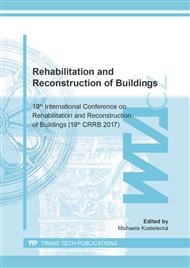p.98
p.104
p.121
p.127
p.133
p.140
p.147
p.153
p.160
Influence of Hydrophobic Agent on Rheological Behavior of Historical Plaster. Part 2: External Temperature
Abstract:
In a previous study, we presented new method measurement rheological properties of hydrophobized plaster in dependence of hardening time. Influence of external temperature on pozzolana plaster is analyzed in this paper, especially plasticity and workability of paste. Main aim of rheological test is determination of flow curves, obtained by applying a succession of constant strain rates for short times at the temperature 10°C and 30°C. Base on the performed experiments, it can be concluded that the temperature have very significant influence on rheological properties of plasters. With an increase in temperature, the application time of the mixture is shorter, from hour to minutes. A comparative measurement with pure lime plaster was done as well.
Info:
Periodical:
Pages:
133-139
Citation:
Online since:
August 2018
Authors:
Keywords:
Price:
Сopyright:
© 2018 Trans Tech Publications Ltd. All Rights Reserved
Share:
Citation:


